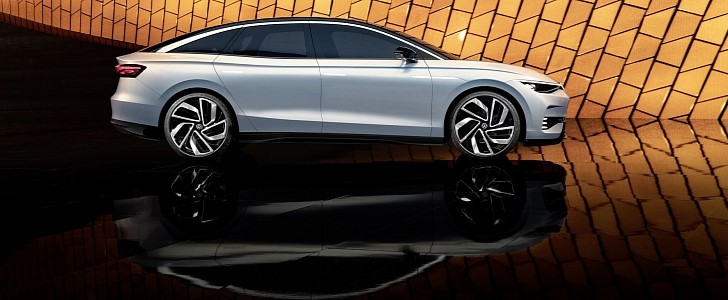After Volkswagen presented the ID.Vizzion, in 2018, rumor had it that the production version would be called Aero B. The new ID. Aero concept shows that the idea may have changed a little bit, even if the new EV still shows how crucial aerodynamics are for electric cars. According to Volkswagen, the ID. Aero can run up to 385 miles (619.6 kilometers) on the WLTP cycle with its 77-kWh battery pack fully charged.
If these numbers are confirmed, the ID. Aero will be the member of the ID family with the most range so far. Curiously, it does not have such a remarkable drag coefficient: 0.23, the same one presented by the first-generation Mercedes-Benz CLA. The CLA 180 CDI Blue Efficiency had a 0.22 drag coefficient back in 2013. It is clear Volkswagen could have done better; perhaps it decided this was good enough.
In the ID family, the vehicle that comes the closest to the ID. Aero is the ID.3 Pro Life, with a range of 358.5 mi (577 km). Ironically, it has a small battery pack (45 kWh) and an only reasonable drag coefficient: 0.267. If the ID. Aero proves aerodynamics matter, the ID.3 Pro Life shows that mass is also fundamental: the lower, the better for range.
Unfortunately, the German company did not disclose how big it is. If it is similar in size to the ID. Space Vizzion concept (its station wagon version), it should be 4.96 meters (195.3 inches) long, 1.90 m (in) wide, 1.53 m (in) tall, have a wheelbase of 2.97 m (in), and a trunk of 586 liters (20,7 cubic feet). Some websites said it was 5.16 m (203.3 in) long, but we could not confirm whether that was correct. It would be weird for it to be so much longer than the electric station wagon.
Volkswagen developed the ID. Aero for the Chinese market, considering how popular sedans still are in the largest car market in the world. The company is expected to start selling its production version there by the second half of 2023.
For Europe and eventually the U.S., the production ID. Aero will also arrive next year. Volkswagen chose the Emden plant to take care of the vehicle pointed out as the Passat successor for carbon-neutral times.
In the ID family, the vehicle that comes the closest to the ID. Aero is the ID.3 Pro Life, with a range of 358.5 mi (577 km). Ironically, it has a small battery pack (45 kWh) and an only reasonable drag coefficient: 0.267. If the ID. Aero proves aerodynamics matter, the ID.3 Pro Life shows that mass is also fundamental: the lower, the better for range.
Unfortunately, the German company did not disclose how big it is. If it is similar in size to the ID. Space Vizzion concept (its station wagon version), it should be 4.96 meters (195.3 inches) long, 1.90 m (in) wide, 1.53 m (in) tall, have a wheelbase of 2.97 m (in), and a trunk of 586 liters (20,7 cubic feet). Some websites said it was 5.16 m (203.3 in) long, but we could not confirm whether that was correct. It would be weird for it to be so much longer than the electric station wagon.
Volkswagen developed the ID. Aero for the Chinese market, considering how popular sedans still are in the largest car market in the world. The company is expected to start selling its production version there by the second half of 2023.
For Europe and eventually the U.S., the production ID. Aero will also arrive next year. Volkswagen chose the Emden plant to take care of the vehicle pointed out as the Passat successor for carbon-neutral times.








